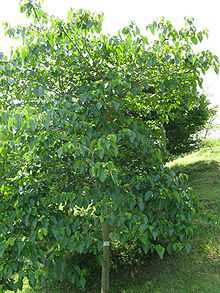Vernicia
From Wikipedia, the free encyclopedia
| Vernicia | |
|---|---|
 | |
| Vernicia fordii | |
| Scientific classification | |
| Kingdom: | Plantae |
| (unranked): | Angiosperms |
| (unranked): | Eudicots |
| (unranked): | Rosids |
| Order: | Malpighiales |
| Family: | Euphorbiaceae |
| Subfamily: | Crotonoideae |
| Tribe: | Aleuritideae |
| Subtribe: | Aleuritinae |
| Genus: | Vernicia Lour. |
| Species | |
|
See text | |
The genus Vernicia, commonly referred to as Tung or Tung-oil Tree, is a genus in the spurge family Euphorbiaceae, comprising three species, native to eastern and southeastern Asia.[1][2]
They are shrubs or trees growing to 20 m tall. The leaves are alternate, broad, entire to palmately lobed; they may be either deciduous or evergreen. The flowers may be either monoecious or dioecious.[2]
- Species
- Vernicia cordata (Thunb.) Airy Shaw. Southern Japan.
- Vernicia fordii (Hemsl.) Airy Shaw. Southern China, Burma, northern Vietnam.
- Vernicia montana Lour. Southern China, Indo-China.
The species have often been included within the related genus Aleurites. Other synonyms include Ambinux Comm. ex Juss., Dryandra Thunb., and Elaeococca Comm. ex Juss..
Cultivation and uses
All three species are cultivated for the oil in their nuts, used in the manufacture of linoleum, paint, varnish, etc.[2]
References
This article is issued from Wikipedia. The text is available under the Creative Commons Attribution/Share Alike; additional terms may apply for the media files.